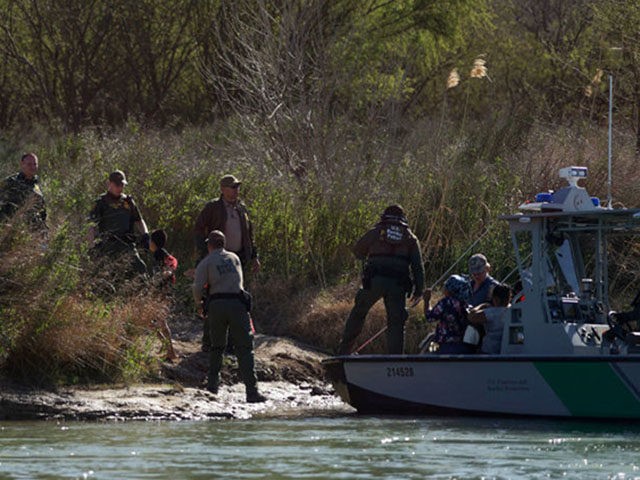The majority of migrants encountered by U.S. Customs and Border Protection (CBP) along the southwest border so far this year hailed from outside the three countries in Central America’s Northern Triangle (NT) region, government data shows.
Guatemala, Honduras, and El Salvador make up the Northern Triangle. Border agents have come across more border crossers from the rising number of countries outside the Northern Triangle than those from within the region each month between January and May, according to the latest 2021 data maintained by CBP.
The shift reflects a growing number of migrants from outside the NT, mostly job-seeking Mexicans — and a dramatic rise in global migration. For example, according to CBP data, the border agents encountered more South Americans from Ecuador (11,691) than Salvadorans from the Northern Triangle (10,422) in May, the latest month for which data is available.
In May, border agents encountered 180,000 migrants (including repeat border crossers), the highest number in two decades.
That month, the number of non-NT migrants (111,237), mainly from Mexico (70,630), encountered by U.S. Border Patrol and the Office of Field Operations (OFO), both components of CBP, exceeded those from within the Central American region (68,797) by 60 percent, marking a potential shift in migratory trends.
The potential shift makes a mockery of the White House’s plan to tackle the record surge of migrants crossing the U.S.-Mexico border, which largely revolves around addressing the supposed “root” causes of migration in the NT countries.
President Joe Biden tasked Vice President Kamala Harris in March to tackle the “root causes” of migration from Guatemala, Honduras, and El Salvador.
However, Democrats, their establishment media allies, the White House, immigration advocates, and Republicans all gave Harris flak for her visit to Guatemala and Mexico in early June, her first foreign trip as VP. It appears U.S. Secretary of the Department of Homeland Security (DHS) Alejandro Mayorkas has taken over from Harris, whose team said she does not want to be linked to the border crisis because it could hurt her chances of becoming president.
After Harris’ visit was deemed a failure by some anonymous White House sources, Biden deployed Mayorkas, who oversees CBP, to Mexico. Mayorkas, not Harris, is scheduled to visit Guatemala on Tuesday.
VP Harris blames the border crisis on Northern Triangle countries, while Guatemala, El Salvador, and Mexico — echoing Republicans and other critics — have repeatedly accused the crisis on the Biden administration’s overwhelmingly welcoming policy of incentivizing Central Americans to leave their home country. Republicans and some Mexican officials note that Biden’s decision to rescind his predecessors’ migration policies has also contributed to the border problems.
Migrants from Mexico and the Northern Triangle have traditionally been the top drivers of migratory trends. Most non-NT migrants stopped by authorities this year are Mexican.
So far this year, the number of Mexican border crossers exceeded those from the Northern Triangle on only two (January and May) of the five months for which CBP data is available.
Compared to the countries outside the Northern Triangle individually, including Mexico, the region’s three countries are the predominant source for the migrant surge that reached historic levels under Biden’s watch this year.
However, when taken all together, migrants from the growing number of non-NT countries exceed those from three nations within the Central America area this year.
In May, border agents came across a growing number of migrants from South American countries fleeing economic devastation wrought by the Chinese coronavirus pandemic, including a record number of Venezuelans.
Some Venezuelan migrants reportedly revealed that the economic downturn caused by the Chinese coronavirus is driving many South Americans, namely from Brazil and Ecuador, to the U.S.
In late June, experts deemed South America the new Chinese coronavirus hotspot.
In recent weeks, the Panamanian government has warned that a record wave of migrants mainly from Haiti and Cuba, but also from as far as Asia, Africa, and the Middle East is heading to the U.S.
Panamanian authorities, who smuggle U.S.-bound migrants entering their territory illegally towards America after crossing the deadly Darien Gap jungle and receiving aid from the State Department, recently detained some terrorists.
The migrant surge triggered a worsening border crisis that begun to materialize at the end of the Trump administration and intensified under Bidens’ presidency, reaching historic levels in recent months. Border crossings under Biden have marked a dramatic increase from those during his predecessor’s tenure, which reached record lows.
In March, the president found it necessary to appoint Ricardo Zúñiga to serve as his special envoy for the Northern Triangle, even as his administration remained adamant that the situation at the U.S.-Mexico border was “not a crisis” despite evidence showing otherwise.

COMMENTS
Please let us know if you're having issues with commenting.